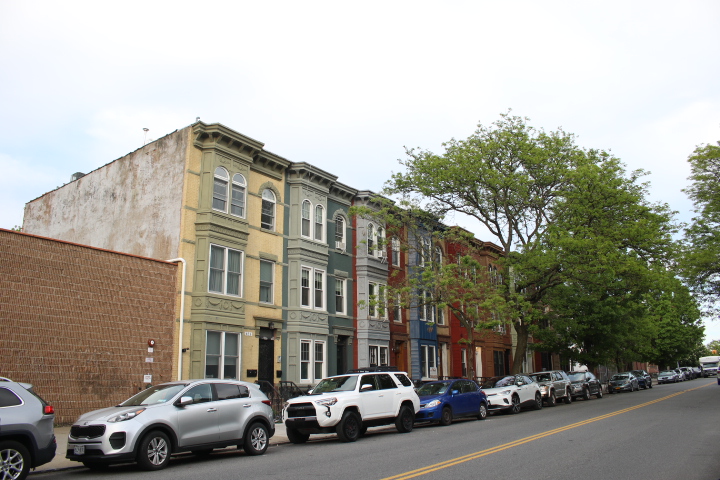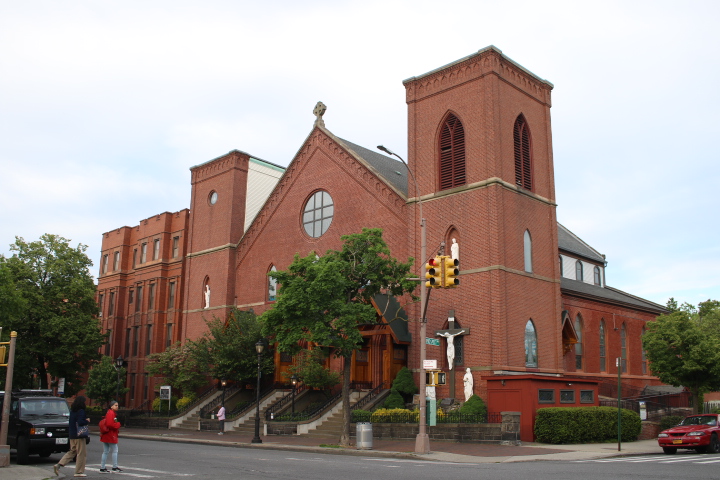
Preserve Community.
The landowner of Arrow Linens on Prospect Avenue in Windsor Terrace wants to sell the property for a whopping $70 million. Potential developers want to buy it and build two 13-story high rise. This would destroy the character of this historically quaint neighborhood and potentially displace many in the future. Housing Not Highrise’s is fighting to preserve the community and charm of Windsor Terrace.
What makes brooklyn?
Unlike Manhattan, Brooklyn’s charm is its human scale. Manhattan’s buildings soar into the stratosphere while those in Brooklyn are firmly planted on Earth. Brooklyn is the best of both worlds: it is in the city, but is relatable and unaffected. It is walkable and also driver friendly. Manhattan is easily accessible via train. The sky is visible and streets aren’t engulfed by shadow by 2 pm since buildings are typically no taller than five stories. Most houses in Brooklyn have yards with greenery and even trees (despite the misleading title of that book a Tree Grows in Brooklyn).
While Brooklyn’s charm is clearly its earthiness, it does have one major problem. Housing is a looming issue across all of NYC. People are willing to pay top dollar for studio apartments, which in any other city wouldn’t cost more than $700 a month. But here people are willing to be less comfortable and pay upwards of $2000 since there is so little available on the market. People really want to live in Brooklyn.
The History of Windsor Terrace.
Windsor Terrace’s appeal has always been its small-town feel. It was built up in the 1800s when a real estate developer, William Bell, bought it. Bell named it after a common place name in England, which is obviously Windsor. Terrace refers to the raised garden beds of many of the houses between Prospect Park West and 10th Avenue. Windsor Terrace became a popular destination due to its location on the very north western edge of Flatbush, yet its proximity to the city of Brooklyn (Windsor Terrace was not a part of Brooklyn yet in those days). People loved its suburban ambiance then as much as they do now. Many Irish moved to the area and live there to this day.
windsor terrace’s charming community.
What makes Windsor Terrace so distinct from larger NYC is naturally its coziness. Time goes by a little bit slower. You can stroll leisurely down the sidewalk without getting in someone’s way. Windsor Terrace is a snapshot of Brooklyn’s past and the quiet gives you room to think and reflect on the present. There is also a strong sense of community. One key aspect that makes it a jewel is it’s the perfect place to start a family, yet, Manhattan is easily accessible via the F train. It is important to preserve the community of Windsor Terrace.
Windsor Terrace is truly one of the most sought-after locales in Brooklyn and perhaps all of NYC. Windsor Terraces’ charm is directly opposed to the chaos of Manhattan and larger NYC. It is an island of quiet and calm in a sea of loud, bustling city. Manhattan is loved for what it is by Brooklynites, but that is why we visit instead of live there.
Not all think it’s important to preserve community.
Arrow Linen is going to be rezoned into residencies again. Windsor Terrace residents were thrilled to find out last year that there would be new housing put up at Arrow Linens on Prospect Avenue. They were not so enthused to discover a proposal that would result in two 13-story buildings however. Arrow Linen applied to NYC for rezoning without consulting with the Windsor Terrace community. Arrow Linen’s motivation is purely avaricious and self-serving. Housing Not Highrises fights to preserve Windsor Terrace’s unique character and community.
Why Housing Not Highrises wants to preserve community.
While the preservation of Windsor Terrace’s character is important there is much more at stake. Many people’s lives are at risk if this deal goes through. As the deal stands no one who is currently living next to Arrow Linens would be displaced. Developers will smell blood however if this plan is allowed to go through. Eventually developers would attempt to buy out the remaining tenants and knock down the row houses there. Developers would get their way eventually since the right price is impossible to refuse for most.
A healthy community is made up of happy citizens. Citizens can’t be happy if their living situation is not stable. Housing Not Highrises recognizes the need to protect people who already live on Prospect Avenue and those who are desperately seeking housing. It is clearly impossible to preserve community if residents are leaving.

Housing Not Highrises seeks to preserve Windsor Terrace’s Community.
Another phrase Housing Not Highrises uses is “contextual housing”. It is housing that fits within the contextual elements that comprise Windsor Terrace. Windsor Terrace is a human scale community and caters to the real needs and concerns of humans, namely peace, comfort, and beauty. Architecture addresses the need for community since many houses have porches. The houses that only have stoops instead of porches still provide an important meeting place for neighbors. Houses are usually no taller than three stories. Living on the third floor you can still hear and see what is happening at street level. As we will discuss later on, almost all of these features are missing entirely from highrises.
Housing Not Highrises has held two community meetings at the Holy Name of Jesus that have been passionate inquiries. The last one was on April 16.
Why Highrises are Inferior to Human Scale Housing.
Humans are unsurprisingly not meant to live higher than two stories or we would have evolved to be birds. Clearly life isn’t perfect though and it’s better to have a house 200 feet in the air than no house at all. It turns out that living in high rises likely isn’t good for mental health or the environment however.
Living in a highrise is an isolating experience. The design of most high rises doesn’t encourage socialization. There are only a couple of public rooms at most in any apartment complex: laundry rooms and community rooms. Most hate doing laundry, so how many friendships could be forged there? There are also community rooms, but these are meant to be used for birthday parties and other special events. There is less opportunity for spontaneous socialization in high rises. When you live so high up you are totally disengaged from any of the events happening at street level. You might be able to hear the faint sound of horns blaring, but that is about it.
Highrises are not that good for the environment either despite claims. Many believe that since stacking people on top of each other creates less of a literal footprint it is more ecologically friendly. There is less lumber used, but when you consider how much fuel is required to supply water to and to heat high rises that fact becomes less impressive. There is also the problem of increased demand for plumbing. Windsor Terrace already has flooding problems, so would a high rise contribute to it? This was a concern raised at the last Housing Not Highrises meeting.
Highrises do not foster community or mental health.
Curved lines and natural tones appeal to the human eye and put us at ease. While this is something that regular housing neglects frequently as well, it is especially missing in high rises. High rises are made up of a bunch of right angles, which don’t put humans at ease. This is because high rises are designed to be as time-efficient as possible so they can be filled with renters and make money. Some high rises have wood flooring at least, but many just have linoleum.
Mental well-being is influenced by the environment and surroundings. An included link to a study from Belgiam about self-rated health interestingly demonstrates that bad health generally increases as floors get higher while those with good health tended to live on the fifth floor or lower.
The other problem with high rises is it’s practically impossible to build community, let alone preserve it. Since there are very few shared spaces there is little opportunity for spontaneous socialization, as mentioned previously. There is also evidence that high rises contribute to crime in some regards and lack of trust between neighbors.

How to provide housing and preserve community.
You don’t have to sacrifice one or the other. Windsor Terrace can receive new housing and preserve its community. A six-story building would be reasonable for the local surroundings. There is one problem though: developers love high rises because they are able to turn a profit from them more easily since there are more occupants contributing money. Mayor Eric Adams can assuage developer’s fears of lack of return by investing in contextual, human scale housing through his City of Yes housing program.
Arrow Linen’s deal would set a precedent that would only encourage selfish developers to prey on Windsor Terrace further. A high rise on Prospect Avenue would throw the entire block visually off-kilter. Developers would then say “it looks like we need to add more high rises since it looks so bad!” The shadow from a 13-story high rise would creep all the way to 15th street at certain times of the day, so this would impact those in Park Slope as well. This deal must not be allowed to happen!
As always I, and the team at Brooklynites, thank you for reading. Click back soon. <3
Read about the history of the epic Brooklyn Bridge:
https://brooklynites.nyc/the-brooklyn-bridge-made-new-york-city/
Read about the hip vintage store BLK MKT VINTAGE:
https://brooklynites.nyc/blk-mkt-vintage/
Sign Housing Not Highrises’ petition:
https://housingnothighrises.org
A study from Belgium about self-rated health on various high rise floors:
https://www.ncbi.nlm.nih.gov/pmc/articles/PMC5052143
The history of Windsor Terrace:
https://en.wikipedia.org/wiki/Windsor_Terrace,_Brooklyn
The Effects of Building Size on Personal Crime and Fear of Crime:

